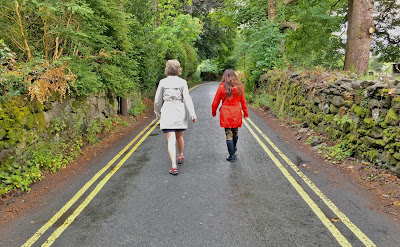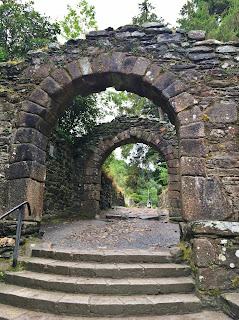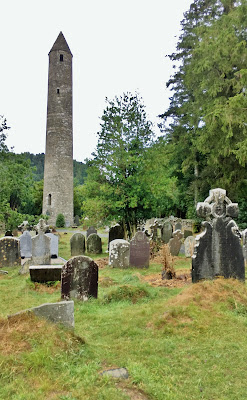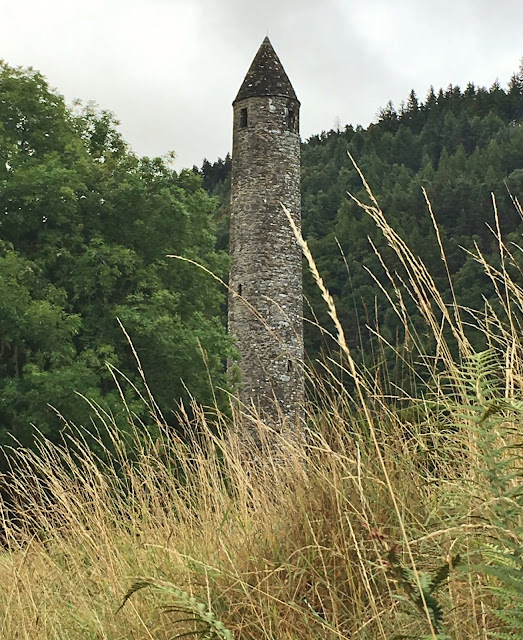45 miles south of Ireland's bustling capital city of Dublin, lies a remote-feeling, ancient monastic settlement. Nestled in a wooded valley of the Wicklow Mountains, the round tower of Glendalough rises up as a beacon for the pilgrims of long ago and the tourists of today...
I awoke to the sounds of drops of water falling off a roof onto gravel and the soft cooing of a dove. As my eyes adjusted to the light in the room, I felt the odd sensation of not remembering where I was. Looking around at my surroundings I was surprised to find I was in a dormitory room, and then my whereabouts all came flooding into my memory at once...I was in a hostel in Ireland!
 |
| The TWO-LANE Road To Glendalough |
It seemed like we were all still on North American time and we were up before 7 am; all except for our teenager Liam. We dressed and snuck through the quiet halls down to the breakfast room for a coffee, but it didn't open until 8am. Instead, we walked down the quiet country road towards the great round tower of Glendalough that we could see poking out from the tops of the trees. Check out my blog post on How To Have Glendalough All To Yourself.
There is a state-of-the-art visitor centre at Glendalough, but it didn't open until 9:30, so we thought we would explore the site since it is free and always open.
 |
| Entrance To Glendalough |
Following the narrow road from the hostel past peaceful sheep pastures to the Glendalough Hotel, we came to a set of ancient granite stone arches. Entering that archway a path led us along to the gateway that signifies we were now on the hallowed grounds of the ancient inner monastery. Glendalough was founded by St Kevin (498-618-yup, 120 years; old as dirt) in the 6th century. There was already a small hermitage here built overtop a Pagan sacred site when St. Kevin crossed the Wicklow Mountains and arrived in Glendalough. Within just over 100 years the settlement grew into a city of over 1,000 people and became one of the most important monastic sights in Ireland. Stepping through the archway of Glendalough that misty morning was crossing a threshold into another time and I found the hairs on my neck stood up as I walked under the arches. In the days of the monastery, crossing the threshold of Glendalough meant that you had asylum from authorities for 90 days; unless you converted and became a monk. If not, you were tossed out to the wolves on day 91. No wonder it became such a huge settlement!
 |
| Round Tower of Glendalough |
Once inside the stone walls, we were drawn over to the 30 meter (110 foot) round tower that stands like a sentinel guarding the sea of high crosses and tombstones as it had for almost 1,000 years. The tower was reconstructed in 1876 from its original slate stones after being destroyed by a lightning strike. There are about 65 round towers scattered around Ireland, and they served primarily as a bell towers in Celtic churches as their Irish name translates: "cloigthithe" or bell house. The doors to the round towers are always elevated therefore giving the round base of the tower more strength.

The modern visitor centre at Glendalough has an excellent display on round towers and early Irish Celtic monastic life. The visitor centre also has an informative 20-minute film on Celtic Christianity in Ireland, a small museum with artifacts from the site, a model of the monastic city and offers once a day 45 minute guided tours. The entrance fee to the visitor centre is €5, and as of 2018, the parking lots charge €4 (except weekends it is free). Click for more information on the: Glendalough Visitor Centre or other OPW run sites. Don't forget to purchase an Ireland Heritage Card at your first heritage site to save you money on entry to all other places; go to www.heritageireland.ie for more information.
 |
| The Ruins of Glendalough Cathedral |
Several other buildings make up the inner monastic site, such as the larger Cathedral which is just a stone hull with a floor and walls but no roof. Just outside this Cathedral is St. Kevins Cross, a 10-foot tall Celtic High Cross carved from a single piece of granite. Legend has it that if you hug the cross, and can reach your hands around it to clasp your fingers together, your wish of healing will be granted according to one's depth of faith in God. Below is a photo of St. Kevins Cross (to the right of the round tower).
Downhill towards the small river is more buildings such as the tiny "Priests House" which had also been reconstructed from original stone. Some scholars have suggested that this building may have housed the relics of St. Kevin at one time (the whereabouts of St. Kevin's remains are unknown). Further on down the path is the gorgeous little stone church affectionately known as "St. Kevin's Kitchen" because the round bell tower looks like a kitchen chimney pipe. The upstairs or "croft" of the church was perhaps used as a scriptorium or as part of the early university St. Kevin established here. There are several other ruins of churches on the Glendaloch site such as St. Kieran's, St Mary's, Saviour Church and Trinity Church. With seven churches plus a monastic university, you can see why this was the most important Celtic Christian site in all of Ireland.
Glendalough declined in 1152 when there was a shift in church political power and Glendalough was annexed to the diocese of Dublin. Yet, Glendalough remained an important site for pilgrims. In fact, a Pope declared that 7 visits to Glendalough are equivalent to the same indulgence value as one visit to Rome! Even today it can get very busy with pilgrims at Glendalough, especially on June 3 which is St. Kevin's Day.
 |
| Exploring Saint Kevin's Kitchen |

Speaking of kitchens, our stomachs were starting to grumble and it was time for breakfast back at the hostel. Besides that, other tourists had begun to arrive at the monastic site, taking away from the mysterious vibe that morning. Back at the hostel, we found our son Liam in the common area along with a group of other young people huddled near the router with phones in hand, connecting to the wifi. During the self-serve continental breakfast we had in the dining hall, Liam declared that he liked the hostel and thought he may give backpacking a try after high school. My heart secretly swelled with joy at this thought, and I mentally gave myself a high-five for instilling the value of travel in my child.
Sure, I told Liam. I may even come backpacking with you!



2 comments:
Thank you for posting about you visit to Glendalough. It revived special memories of my trip there in 2001. I agree about the “vibe” present in that sacred space.
Thank you, NMJ! I am happy the article sparked some special memories of Glendalough for you. Ireland is such an incredibly spiritual place :)
Post a Comment